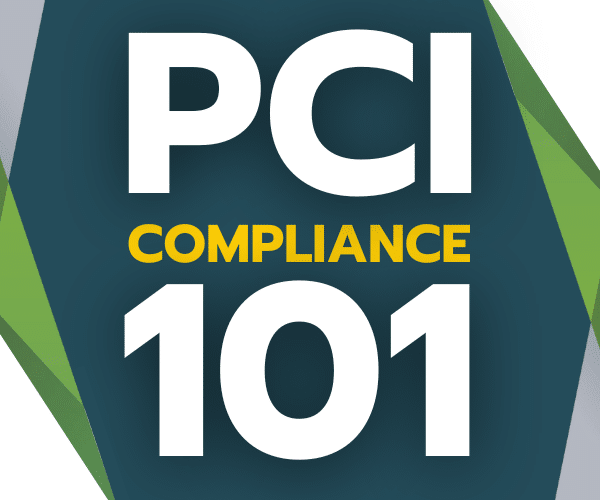As we continue to work away from being a cash based society – for better or for worse – ensuring the security of credit card information has become essential for businesses across all industries.
This is where PCI compliance comes in to ensure your payment data is secure. PCI compliance refers to the Payment Card Industry Data Security Standard (PCI DSS), a set of security standards designed to protect cardholder data and reduce fraud. Any business that handles credit card payments, whether large or small, must comply with PCI standards. This article explores what PCI compliance is, who needs to adhere to it, and the baseline requirements that must be met.

What is PCI Compliance?
PCI Compliance refers to following the guidelines set forth by the Payment Card Industry Data Security Standard (PCI DSS). Created by major credit card companies (Visa, Mastercard, American Express, Discover, and JCB), these guidelines are designed to ensure that businesses processing credit card payments handle, store, and transmit cardholder information securely.
The standards focus on safeguarding the integrity of payment systems and ensuring that businesses take necessary precautions to prevent data breaches and fraud.
Who Does PCI Compliance Apply To?
PCI compliance applies to any organization that accepts, processes, stores, or transmits credit card information. This includes businesses of all sizes, from large enterprises to small mom-and-pop shops, as long as they handle payment card data.
There are four levels of PCI compliance based on the number of card transactions a business processes annually:
- Level 1: Merchants processing over 6 million transactions annually.
- Level 2: Merchants processing between 1 million and 6 million transactions annually.
- Level 3: Merchants processing between 20,000 and 1 million e-commerce transactions annually.
- Level 4: Merchants processing fewer than 20,000 e-commerce transactions annually or up to 1 million total credit card transactions annually.
Each level has specific requirements for validation and compliance, but the baseline standards remain the same across all levels.
Baseline Standards for PCI Compliance
To be PCI compliant, organizations must adhere to 12 baseline requirements grouped into six broader goals. These are the foundation for maintaining a secure payment environment.
1. Build and Maintain a Secure Network
- Requirement 1: Install and maintain a firewall configuration to protect cardholder data.
- Requirement 2: Do not use vendor-supplied defaults for system passwords and other security parameters.
Firewalls act as a first line of defense by preventing unauthorized access, while changing default passwords ensures that common, easily guessed passwords are not used.
2. Protect Cardholder Data
- Requirement 3: Protect stored cardholder data.
- Requirement 4: Encrypt transmission of cardholder data across open, public networks.
Cardholder data must be encrypted, both at rest and in transit, to prevent unauthorized access or theft.
3. Maintain a Vulnerability Management Program
- Requirement 5: Protect all systems against malware and regularly update antivirus software.
- Requirement 6: Develop and maintain secure systems and applications.
Regular updates to software and antivirus programs help prevent vulnerabilities that could be exploited by cybercriminals.
4. Implement Strong Access Control Measures
- Requirement 7: Restrict access to cardholder data by business need to know.
- Requirement 8: Assign a unique ID to each person with computer access.
- Requirement 9: Restrict physical access to cardholder data.
Access to cardholder data should be limited to authorized personnel only, and physical access to data storage locations must be controlled.
5. Regularly Monitor and Test Networks
- Requirement 10: Track and monitor all access to network resources and cardholder data.
- Requirement 11: Regularly test security systems and processes.
Monitoring systems and testing security measures ensures that businesses can detect any suspicious activity or potential breaches before significant damage occurs.
6. Maintain an Information Security Policy
- Requirement 12: Maintain a policy that addresses information security for employees and contractors.
Third-Party Payment Processors
In order to circumvent these requirements – or as a way to shift compliance requirements and the associated risk outside of the business – consider using a third-party payment processor.
Third-party payment processors take the onus off of the business owner and put it onto a third-party that specializes in secure, payment processing. This means that when a credit card transaction occurs, it is communicated directly a payment processor which then transfers the funds to your account after deducting their fees.
Some examples of these might include PayPal or Stripe; however, most businesses I work with tend to use more formal payment processors like Authorized.net as they have the systems in place to meet any PCI requirements.
Why PCI Compliance Matters
Non-compliance with PCI standards can lead to severe penalties, including fines ranging from $5,000 to $100,000 per month for violations. Beyond financial penalties, a data breach can cause irreversible damage to a business’s reputation and lead to a loss of customer trust. Additionally, failure to comply could result in the suspension of credit card processing privileges, severely impacting business operations.
PCI compliance is not just a legal obligation—it is a crucial part of protecting customer information and ensuring the safety of your business’s financial transactions. By following the PCI DSS standards, organizations of all sizes can safeguard sensitive payment data, reduce the risk of data breaches, and enhance overall trust with customers. Contact ThrottleNet for help!

Chris Montgomery
ThrottleNet Sales Director
cmontgomery@throttlenet.com



